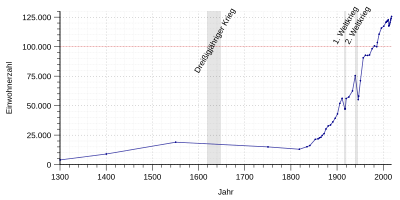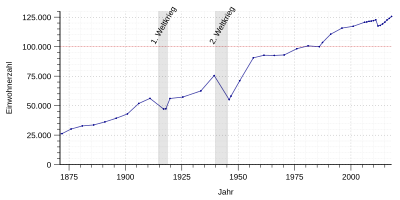Population development of Ulm
This article shows the population development of the city of Ulm .
Population development
Between 1890 (36,000 inhabitants) and 1939 (75,000 inhabitants) the population of the city of Ulm doubled . Due to the effects of the Second World War , Ulm lost around 30 percent (20,000) of its residents by 1945. In 1951 the population had reached the pre-war level again. In 1980, the city's population exceeded 100,000, making it a major city .
As of December 31, 2004, 19,570 residents (16.3 percent) have a foreign passport (over 100 nations). 14.4 percent of the population are under 15 years old, 17.5 percent are 65 years old or older. Thus, like other German cities, Ulm has a relatively low birth rate, but the number of inhabitants is still increasing by 0.5 percent annually due to immigration. On December 31, 2006, the “ official number of inhabitants ” for Ulm was 120,925 according to the state statistical office of Baden-Württemberg (only main residences and after comparison with the other state offices).
The following overview shows the number of inhabitants according to the respective territorial status. Until 1833 it is mostly an estimate, then census results (¹) or official updates from the State Statistical Office. From 1871, the information relates to the “local population”, from 1925 to the resident population and since 1987 to the “population at the location of the main residence”. Before 1871, the number of inhabitants was determined according to inconsistent survey procedures.
|
|
|
¹ census result
literature
- Imperial Statistical Office (Ed.): Statistical Yearbook for the German Empire , 1880–1918
- Statistisches Reichsamt (Ed.): Statistical yearbook for the German Reich , 1919–1941 / 42
- German Association of Cities (Ed.): Statistical Yearbook of German Communities , 1890 ff.
- Federal Statistical Office (Ed.): Statistical Yearbook for the Federal Republic of Germany , 1952 ff.


